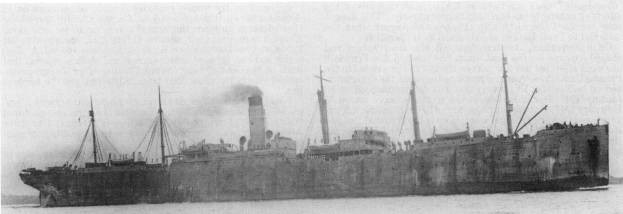Artemis II (Id. No. 2187)
1919

II
(Id. No. 2187: displacement 17,837; 1ength 500.5' (registered); beam 58.3'; draft 27'; speed 12 knots; complement 329; troops 4,000; armament none)
The second Artemis was originally built as the steel-hulled, twin-screw passenger steamship Iowa. Completed in 1902 at Belfast, Ireland, by Harland & Wolff, Ltd., Iowa was owned by the White Diamond Steamship Co., Ltd., and operated by George Warren & Co., of Liverpool, England, until acquired by the German Hamburg-America Line and renamed Bohemia in 1912.
The outbreak of hostilities in Europe in the summer of 1914 stranded many German and Austrian ships, Bohemia among them, in American ports. Seized by American customs officials after the United States entered World War I in April 1917, Bohemia was renamed Artemis, armed with a main battery of one 5-inch and one 3-inch gun, and placed in service as an Army transport. She served as USAT Artemis during World War I. Her battery was removed at Norfolk on 30 November 1918, and she completed her last voyage as an Army transport at New York on 23 February 1919.
Turned over to the Navy at Fletcher's Drydock in Hoboken, N. J., Artemis, given the identification number (Id.No.) 2187, was commissioned there on 8 April 1919, Cmdr. John P. Jackson in command. Assigned to the Cruiser and Transport Force, Artemis sailed for France on 25 April 1919, and reached St. Nazaire on 8 May. Sailing for Newport News, one of the four primary ports of debarkation for the Cruiser and Transport Force, on the 11th, she arrived at her destination on 24 May. Shifting that same day to Norfolk, she commenced her second transatlantic voyage cycle on 1 June.
Besides her embarked returning doughboys, Artemis brought back a cargo of trucks to Newport News on her second voyage, arriving there on 26 June 1919. Shifting to Norfolk the same day, the ship began her third round-trip voyage on 2 July, departing Norfolk for France. Arriving at St. Nazaire on 15 July, Artemis moved to Brest soon thereafter, and began the return trip fromthat port on 21 July. Arriving at Norfolk on 3 August, via Newport News, the ship underwent voyage repairs at Norfolk from 6 to 9 August. She sailed thence for France on the latter day on her last voyage as a naval vessel, reaching St. Nazaire on 21 August. Sailing for the United States on 12 September, Artemis arriyed at New York on the morning of 23 September, mooring at pier 3, Army Base, Brooklyn. Shifting to steamship pier 2, Army Base, on 8 October, Artemis was decommissioned on 18 October 1919. During her career as a Navy transport, she had brought home 11,760 troops. Her name was struck from the Navy list on 18 October 1919, and the ship was transferred to the United States Shipping Board (USSB) for disposition.
The USSB's fourth annual report, for the fiscal year ending 30 June 1920, lists Artemis as being transferred to the France & Canada Steamship Corp. to be operated by that company, but this may never have come to pass, since contemporary merchant vessel registers refer only to her USSB ownership. Likewise, lists of ships operated by the France & Canada Steamship Co. do not contain Artemis. Laid up by 1923, Artemis remained inactive through the 1930's and into World War II, in the hands of the USSB and its successor, the United States Maritime Commission. Acquired by the British Ministry of War Transport in 1941, the ship was renamed Empire Bittern. She remained under the British flag until expended as a blockship off the Normandy beaches in June 1944.


